This is the best Pâte Sablée, sweet shortcrust pastry tart shells recipe you'll ever need. It's a delicious, buttery shortcrust that makes perfect French tart shells! Making French shortcrust pastry - whether it is full-sized tart cases or mini tartlets - is one of the baking basics definitely worth mastering as a home baker!
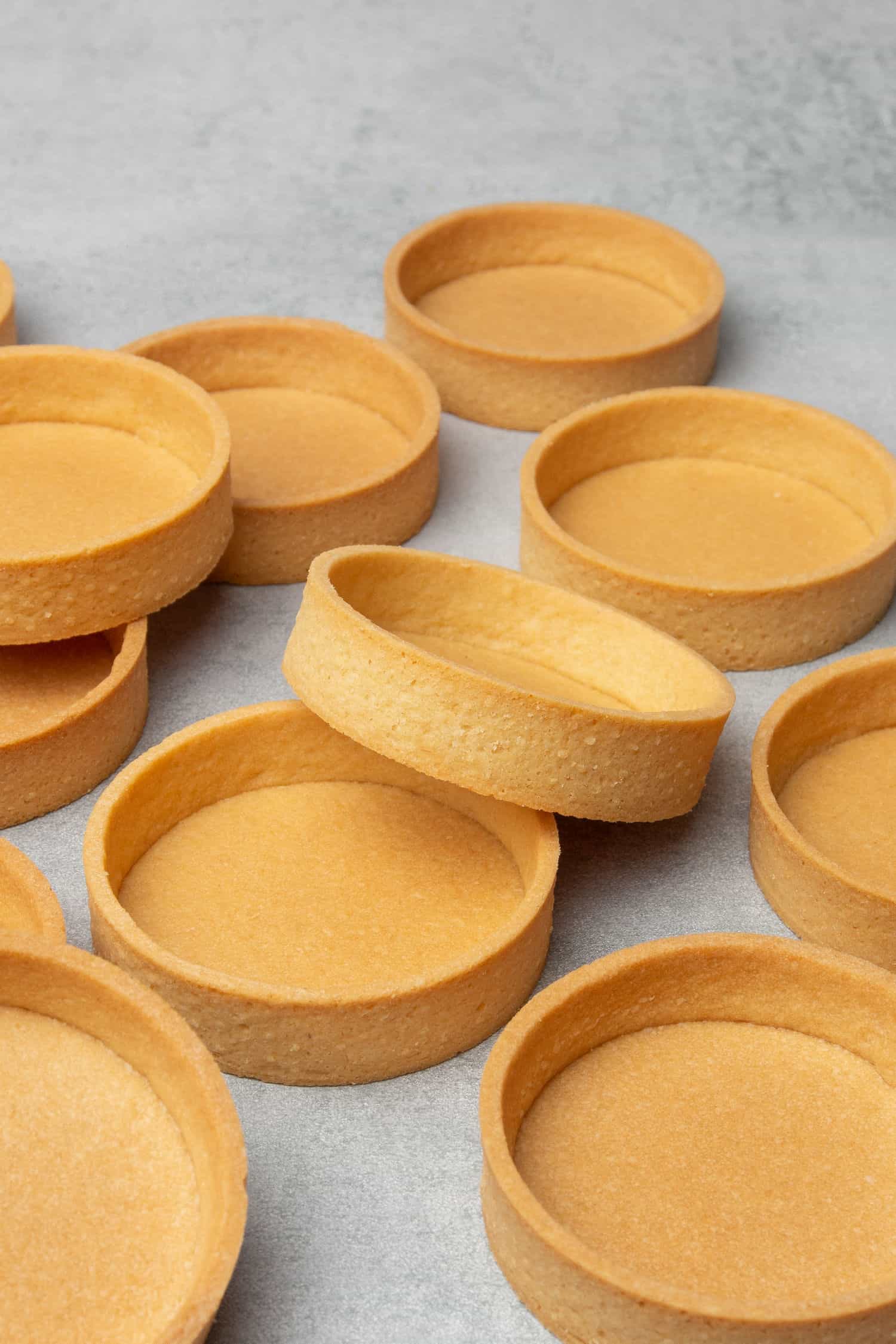
This recipe was one of the first dessert basics I shared on my blog back in 2020. Over time, I've updated it with fresh photos, a new tart shell size, additional baking tips inspired by your questions, and several fillings and ingredient substitution options.
Read what others said about this recipe
"Your recipe is excellent. I have made the recipe a number of times now, and the tart shells turn out simply perfect. Thank you for your very clear instructions and for sharing your knowledge." Miss Glitteryone
"This is the best and only tart recipe that explains everything! I am not a super experienced baker, but I nailed it; thank you so much!" Emer
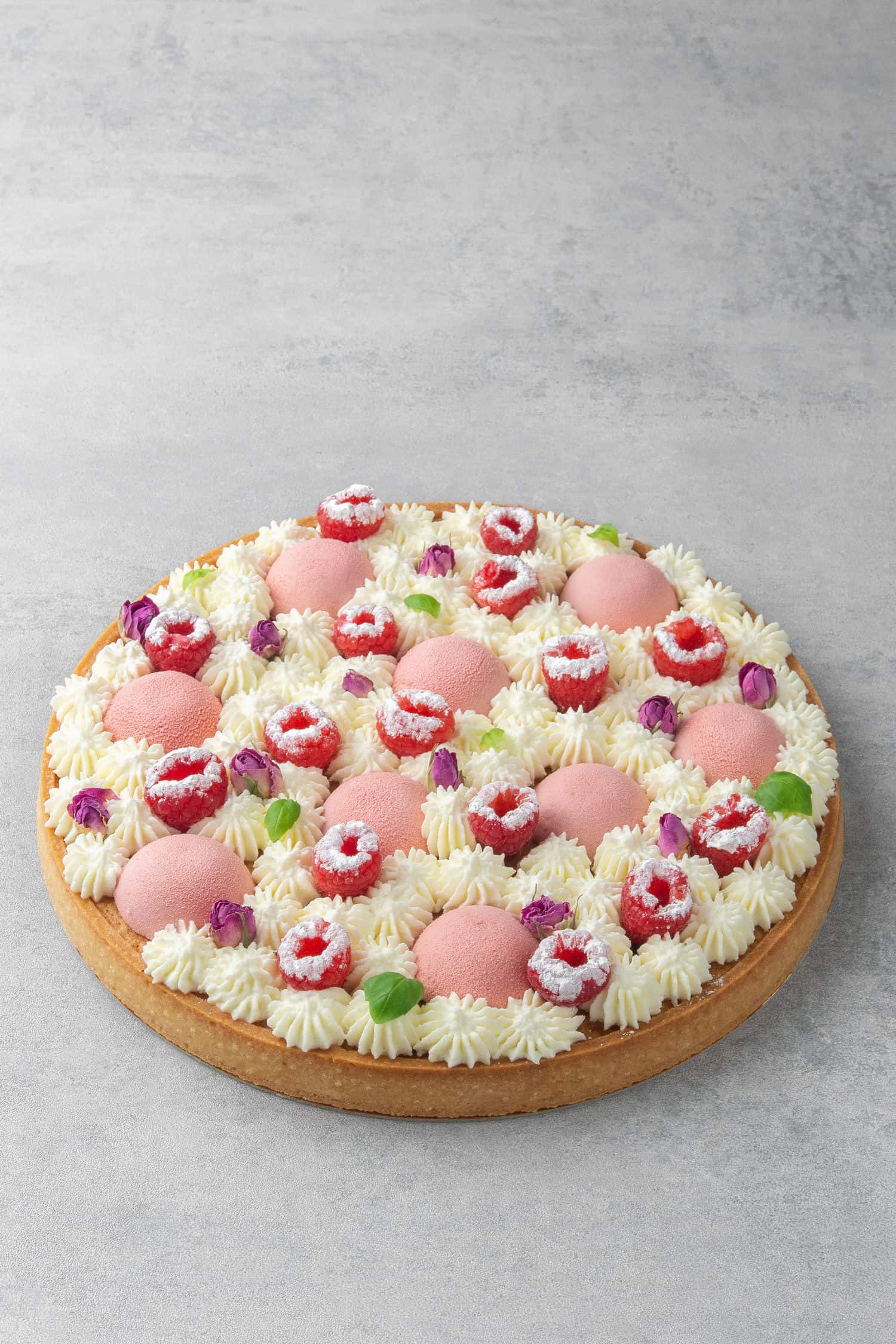
Best Pâte Sablée, Sweet Shortcrust Pastry Tart Shells
This is a professional Pâte Sablée tart case recipe adapted for home bakers in their own kitchens with 100+ 5* ratings.
Tarts and tartlets are one of the most popular pastries worldwide, and this recipe is one of the most popular on my blog. Unlike traditional American flaky pie crust, pate sablee makes a crispier and more cookie-like tart shell. There's no blind baking, and the result is a super delicious, buttery shortcrust that is a sweet but not too sweet, melt-in-the-mouth pastry dough.
The sable pastry recipe contains only a few basic ingredients - like butter, sugar, and flour - yet can be the base of the fanciest, most impressive desserts you will ever make.
In this Pate sablee tartlet shell recipe you will learn
- Using the right ingredients at the right temperature, e.g., 82% fat content European style high-quality unsalted butter used chilled
- Using the right equipment, e.g., perforated tart rings that ensure even baking without blind baking
- Learning the right technique, e.g., how to roll the pastry to an even thickness
I cover all the necessary information you probably haven't read elsewhere. So, your tart cases will turn out exactly like mine. No one will believe you made these neat, professional-looking Pâte Sablée tart cases yourself!
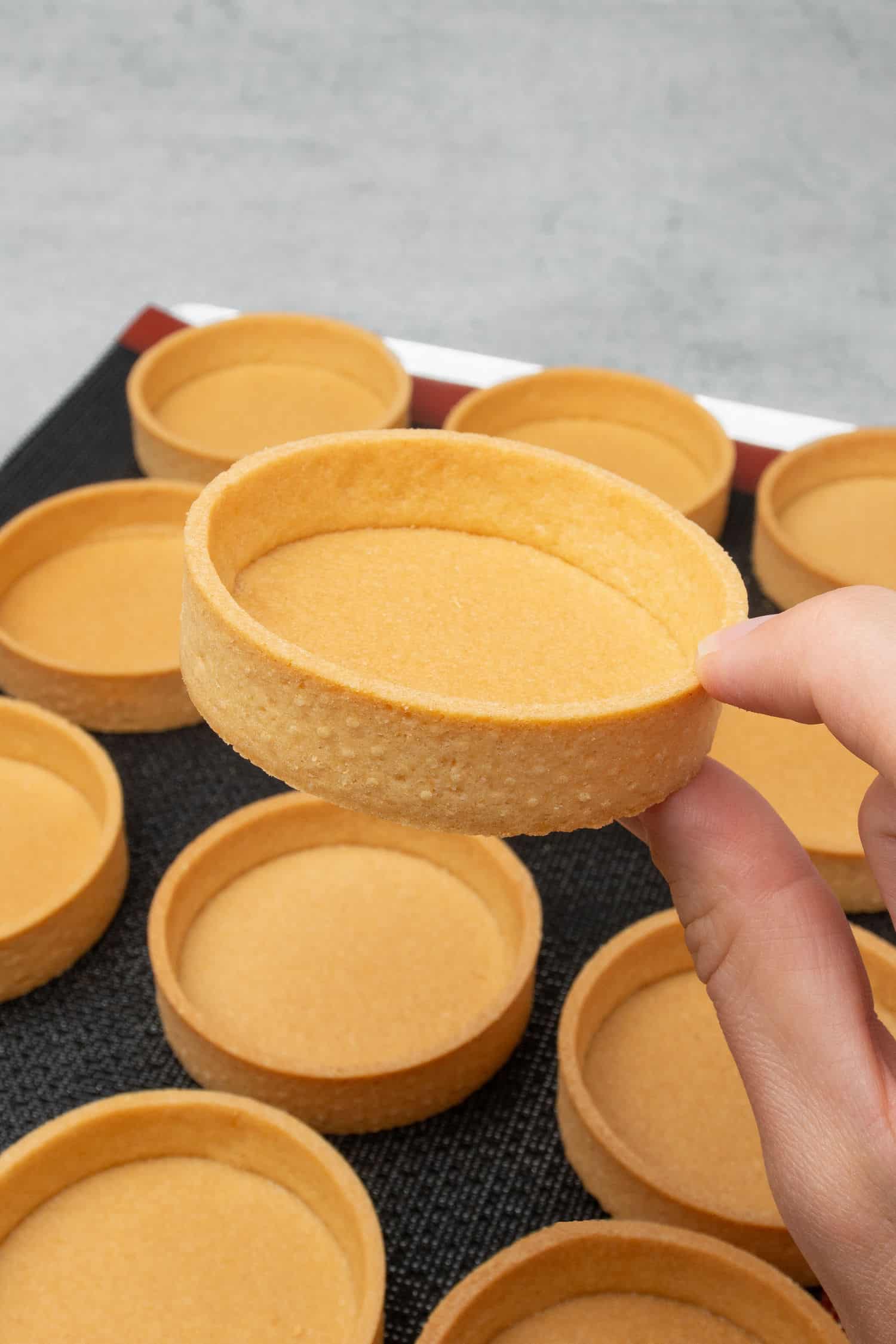
Katalin's Key Take On How hard it is to make homemade Pâte Sablée
Making homemade tart cases using this pâte sablée recipe is actually not that hard. However, it takes practice and precision. Temperature is everything, so you must master when to chill it and when it needs to warm up slightly. The dough will break if it is too cold, but the butter will melt, and it gets sticky if it is too warm. There is also a knack for rolling it to the correct thickness; that's perfectly even for the best tart crust.
The secret behind making beautiful, neat, and delicious French tart crust is all about mastering the technique, understanding how temperature plays in role while working with the dough, and using the right equipment.
This sweet shortcrust pastry tutorial is the only recipe you will ever need to read to make tartlets at home!

My best advice on the ingredients
You must use high-quality butter if you want the best buttery flavor in your pâte sablée. Use unsalted European-style butter with a fat content of at least 82%; it will really make a difference! The butter must be chilled. Take it out of the fridge and cut it into cubes. Then, place it into the freezer for 10-15 minutes before using it in this sweet pastry recipe.
I use pastry flour (which is lower in protein content) for this French tart shell recipe, but you can substitute it with all-purpose flour if you can't find it. Read my flour guide for more pro advice! I prefer to mix it with almond flour for a better taste and crispy texture. Buy good quality ground almonds without skin.
The recipe is also made with egg (which must be at room temperature) and a small amount of powdered sugar and salt, too. This makes the tart case sweet but not overly sweet and balanced while highlighting the delicious buttery flavor. Don't skip the salt!
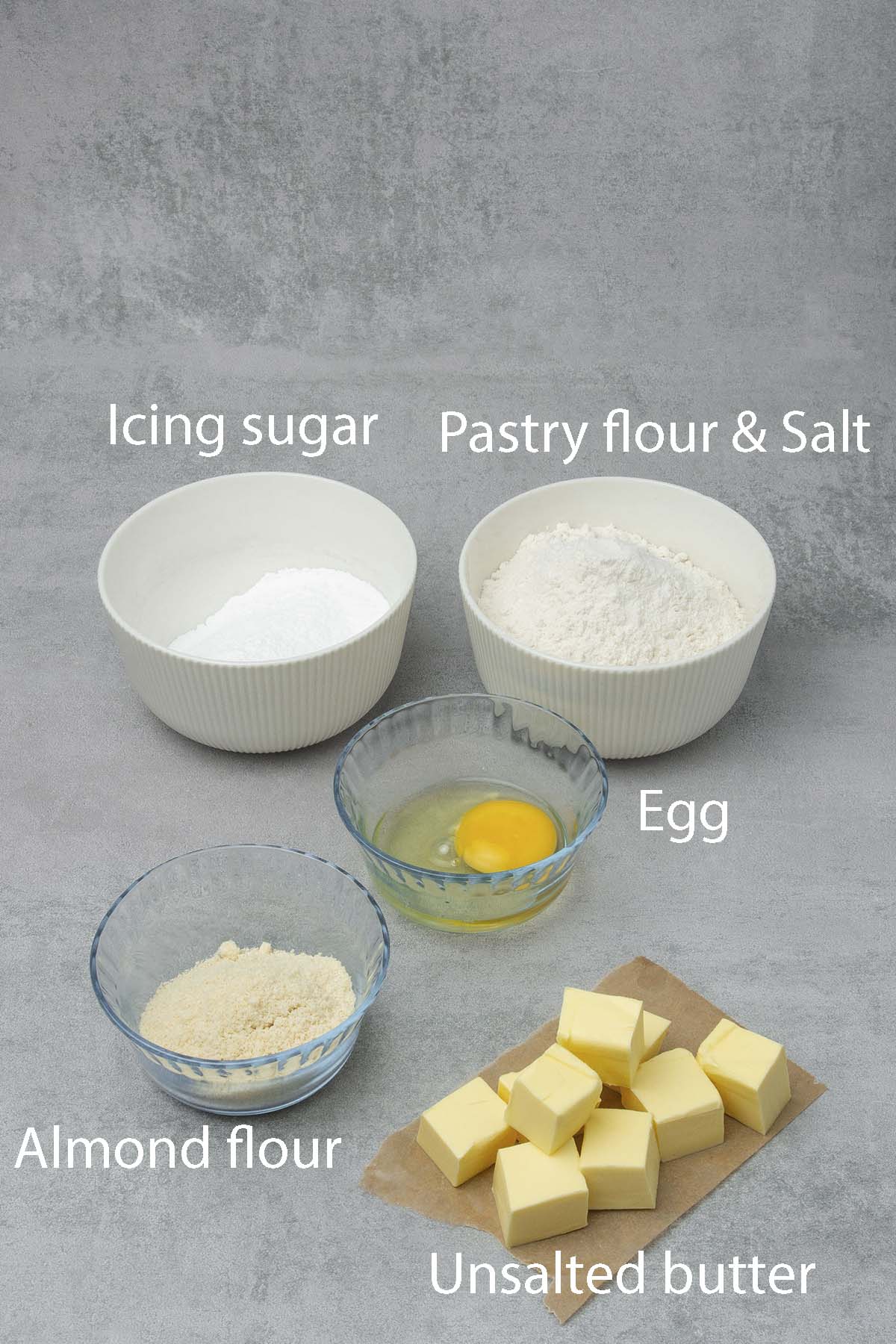
My 5 minutes crumbling method to mix the shortcrust pastry dough
There are two methods in the pastry chefs' world to make sweet shortcrust pastry: the creaming method and the crumbling method. The creaming method requires the butter to be at room temperature, and it is creamed into the powdered sugar before adding everything else. I prefer the crumbling method as it keeps the butter (and the dough) chilled at all times, making it much easier to work with.
Here is how you do it:
Weigh out the butter, cut it into chunks, and place it in the freezer while you prepare the other ingredients. It is essential that the butter is really cold.
Weigh out the dry ingredients (the flour, powdered sugar, almond flour, and salt) and sift them into a bowl to avoid lumps.
To crumble the cold butter chunks into the flour mixture, add them into the bowl and rub the mixture between your hands until it reaches a sand-like texture.

Add the egg and bring the dough together with your hands. It might look crumbly, but do not add more wet or dry ingredients to the recipe. Knead the dough for one or two minutes with the palm of your hand until it becomes smooth. Work quickly to avoid melting the butter. Do not use a mixer or food processor.
Press the dough into a rectangular disk (making it easier to roll out) and wrap it in plastic food wrap. Place it in the refrigerator to chill for 10-15 minutes in case it has warmed and become sticky.
Steal my favorite rolling secret
Once the dough has cooled down, continue rolling it out.
Place it between two silicone baking mats and roll it to an even 2mm thickness. Roll it from top to bottom with an even pressure, and rotate it 90 degrees after each roll. The recipe quantity is designed so that once you roll the dough out, it will reach the silicone baking mats (41.9 x 29.5 cm, 16.5 x 11.5 inches) from edge to edge. You should not need any dusting flour.
Still between the mats, place the dough into the freezer for 10-15 minutes.
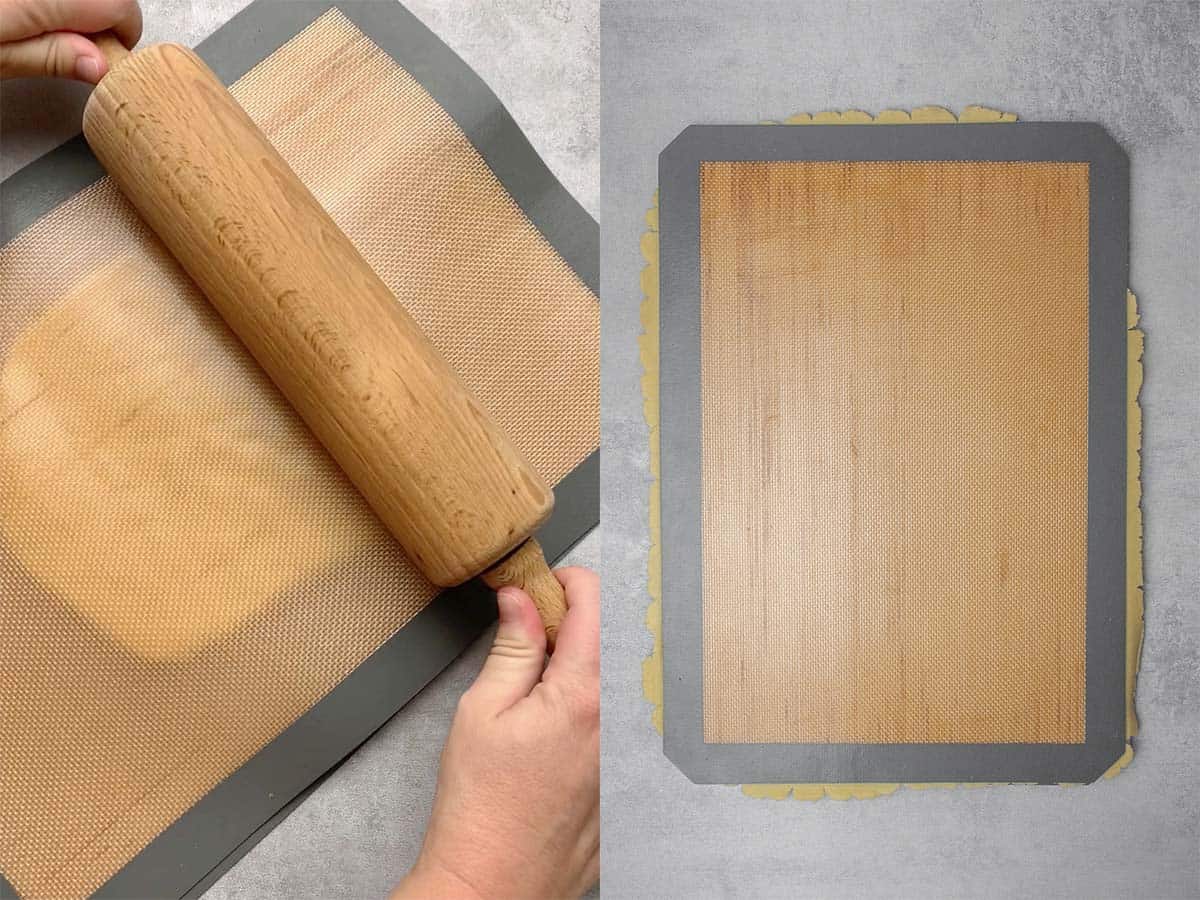
Now time to assemble the tart shells
Take the dough out of the freezer and peel off the top silicone mat. If the dough becomes too soft and warm to handle or seems sticky at any point in the following process, return it to the freezer for 5 minutes. It can tear if it is too warm, but it can break if it's too cold, so judging the correct temperature is vital.
Cut eight long strips from the dough to form the sides of the tart (measure one of the rings to get the correct width, but we will trim them later, so don't worry if they are slightly too wide).
Then, use the base of a perforated tart ring to cut eight circles out of the remaining pastry dough. This will form the bottoms of your tarts. Carefully lift and place each base into the rings.

Now, take the strips and press each one into the sides of each ring and to the bottom to ensure it sticks together. It needs to be pliable enough that it doesn't break but not so warm that it is sticky to the touch.
Place the perforated tart rings with the pastry dough into the freezer for one hour. Don't skip this step!

Baking is the grand finale
Toward the end of the freezing time, preheat the oven to 160°C (320°F).
Take the tart rings from the freezer and trim the top of the dough with a sharp knife to line up with the top of each ring.
Bake the sweet pastry tart shells in the preheated oven for 20 minutes at 160°C (320°F). Then, carefully remove them from the rings. Once you take the tarts out of the oven, wait for a minute or two for the pastry to somewhat contract within the ring. Then, you will be able to remove the rings easily. If the pastry seems to be stuck onto the ring, it means you will probably need to bake it for a few more minutes. Do not force it, as you can easily break it.
After the tart rings are removed, bake the tart shells for an additional 5-10 minutes or until they turn golden brown.
Allow the French tart shells to cool completely on the perforated baking mat before filling.
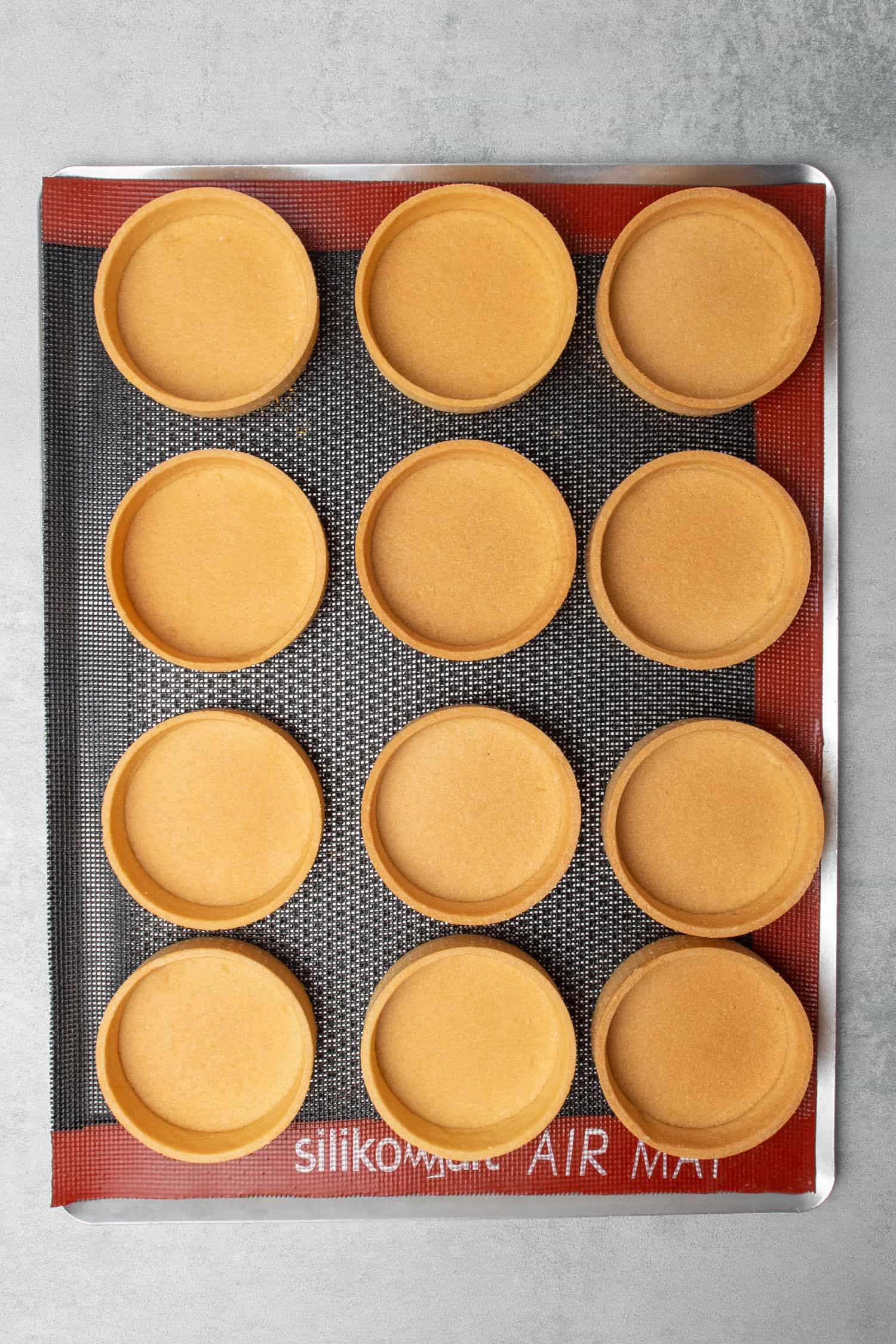
Do not substitute the ingredients
When one ingredient changes, it often requires the whole recipe to be reformulated, as everything plays its part. This is one of those recipes I do not recommend swapping out the butter or using egg substitutes as it will affect the texture and flavor.
The one swap you can make is to replace the almond flour with an equal amount of pastry flour (or all-purpose flour). The pastry won't be quite as crisp, and you will lose the slight marzipan flavor, but you won't need to rework the recipe entirely.
Try some flavor variations
Once you learn the basics of preparing the pastry cases you can play around somewhat with the ingredients. Replace some almond flour with hazelnut flour to make hazelnut tart, for example, or other nut flour. Add citrus zest for a lemony kick or some black sesame seeds like this black sesame tart recipe. Love chocolate? Try adding cocoa powder (Dutch process) to make my favorite chocolate Pâte Sablée recipe.
You can also use this recipe to make simple pâte sablée cookies. Prepare the dough as explained, cut out biscuit circles using a cookie cutter, bake, and enjoy. This tastes especially good when you grate lemon zest into the dough and sprinkle over some granulated sugar after baking!
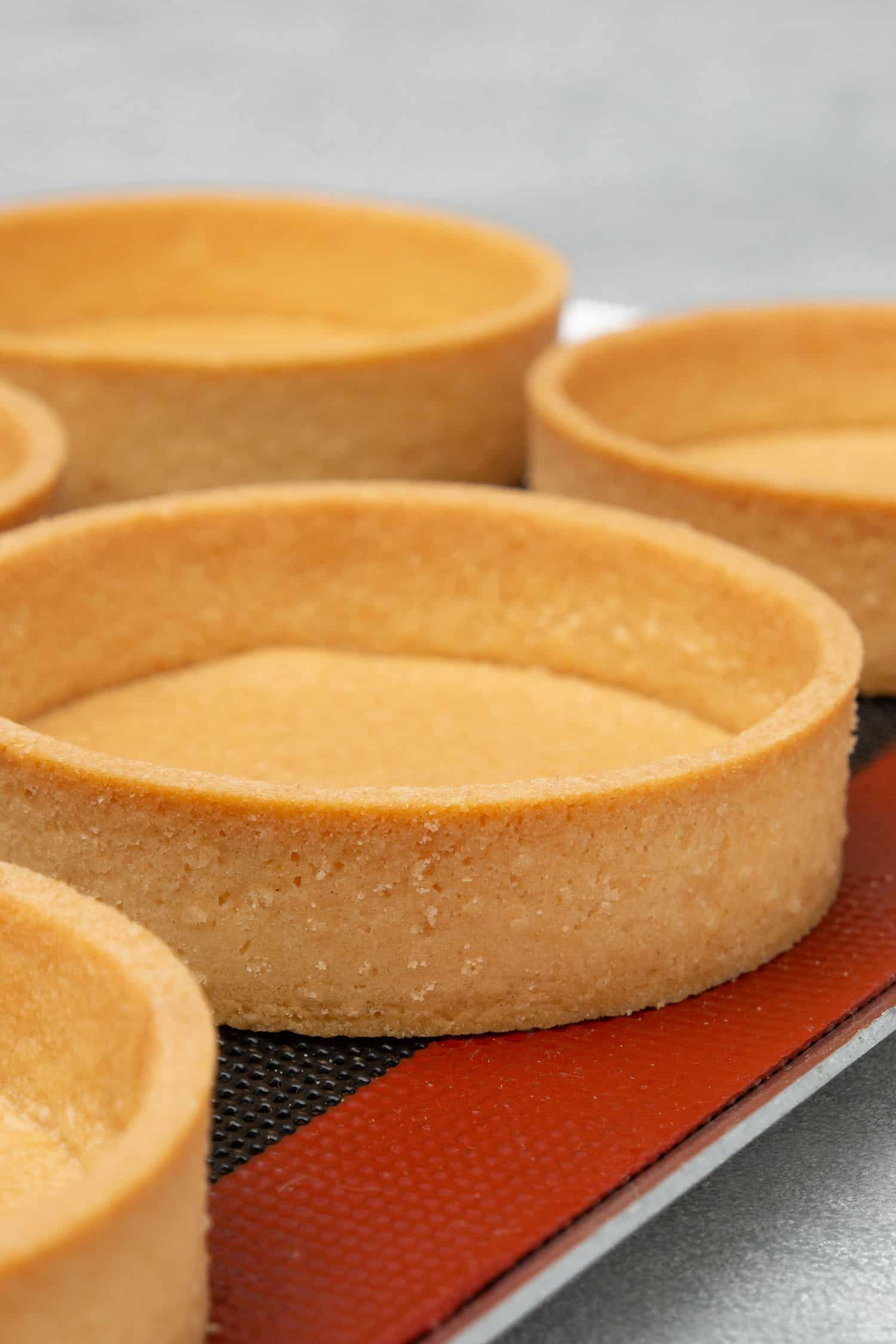
Need to bake ahead? Store and freeze like a pro
Baked tart shells can be stored in an airtight container at room temperature for several days, but make sure the container is sealed tightly. You can refrigerate them to keep them fresh for up to a week, but let them come to room temperature before filling or serving.
You can freeze the raw tart cases before baking for up to three months and bake them as explained above when needed. This is my preferred option, as while you can freeze baked tart cases, they might lose their crispiness a bit. Place the unbaked tart shells in their rings onto a baking sheet and freeze until solid. Then transfer them (still in their rings) to an airtight container or freezer bag.
To freeze the pâte sablée cases after baking, allow them to cool completely, then wrap them tightly in plastic wrap and place them in an airtight container or freezer bag. Do not freeze the tarts once they are filled.
Helpful equipment
You can achieve a neat, visually appealing, professional-looking tart crust by purchasing some basic equipment!
Always weigh ingredients by the gram using a digital scale. When it comes to French pastries, precision is everything!
I recommend rolling the pastry out with a rolling pin between two silicone baking mats, as it minimizes the need for dusting flour and keeps you from handling the dough too much. It’s also possible to use two sheets of parchment paper, but I find the silicon mats are better.
These perforated tart rings are the best investment I have ever made! They allow homogeneous baking due to the even air circulation, and there is absolutely no need to grease the tart rings. The Pâte Sablée dough will stick to its perforated side while baking and contract after baking - so the ring can be removed easily.
While baking the tart shells, use the perforated “air” baking mat straight on top of the oven rack (not in a baking pan or tray) for the air to circulate properly.
All ovens vary, and it is critical you bake at the correct temperature. Use a digital oven thermometer to check your oven is not too hot or cold.
My final expert tips
- Temperature is everything! If your kitchen is warm, you might take the dough in and out of the freezer up to 10 times in between steps to ensure the dough is always at the right temperature to work with. If you are lucky and have a cold kitchen, you might be ok with 2-5 chilling breaks.
- I really recommend using perforated equipment over the blind baking method, but read my article on how to blind bake a tart crust in case you need it.
- Always preheat your oven, and do not use the fan settings for this recipe.
- I have a special technique to get the shells out of the ring: hold the tart shell with both hands and gently press the top on two opposite sides simultaneously, then go around the edge of the tart shells. Never press the middle part, only the top side of the tart shell edges.

Troubleshooting
The pastry dough shrinks while baking - This can also be due to excess water in the dough, which evaporates, so make sure you stick to the specified amount of egg and do not add more liquid. Using butter with a high-fat content of at least 82% will also help. Pastry dough also shrinks while baking due to overworking the dough, so make sure to follow my recommendations on how long to knead the dough (just for a minute or two).
The tart shells don't keep their shape while baking - do not skip freezing the shortcrust dough before baking. This ensures it keeps its perfect, even shape! Another issue can be too low oven temperature so your pastry effectively melts instead of bakes.
The pastry falls out of the tart case while baking - This should not happen if the dough is firm enough when you press it into the ring. If this happens, very quickly open the oven door and press it back with your finger.
The dough puffs up during baking - Ensure that you roll the dough out to 2mm thickness and use perforated equipment rather than the blind baking method.
The tart shell won't come out of the ring - This happens if you assemble the tarts into the rings when the dough is too soft. If the dough temperature is just pliable at the assembling stage (not too cold, not too hot), the pastry is supposed to contract within the ring during baking, which makes it easier to remove. If the tart shells seem stuck onto the ring, bake it for a few more minutes. Do not force it, as it can break.
How to fill these tart shells
Try some delicious tart fillings to enjoy your homemade pâte sablée to the max!
- Strawberry tart
- White chocolate raspberry tart
- Lemon tart
- Raspberry Frangipane tart.
- Chocolate and Salted Caramel tart.
And check out my ultimate collection of tart recipes! Using this basic tart shell recipe, you can make mini tartlets or larger ones in any shape, form, or flavor.
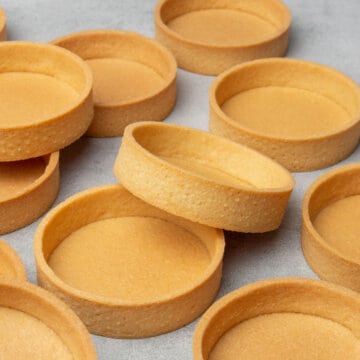
Pâte Sablée, Sweet Shortcrust Pastry Tart Shells
Equipment
- Digital scale
Ingredients
- 90 g (¾ cups) Powdered sugar
- 230 g (2 cups) Pastry flour can be replaced with All purpose flour
- 30 g (⅓ cups) Almond flour
- Pinch of salt
- 110 g (½ cups) Unsalted butter 82% fat content, use it very cold, cut into chunks
- 50 g Egg approx. 1 egg at room temperature
US customary cup measurement is an indicative figure only. Measure the ingredients with a digital scale by weight (gram). Baking is art but also science which requires precision and accuracy.
Instructions
Assemble the dough
- Cut the butter into chunks and place them in the freezer for a few minutes.
- Sift the dry ingredients together: flour, powdered sugar, almond, and salt.
- Add the cold butter chunks to the dry ingredients and rub the mixture between your hands until it reaches a sand-like texture.
- Add the egg to the mixture and combine with your hands until the dough comes together.
- Knead the dough with the palm of your hand for one to two minutes, just until it becomes smooth. Avoid over-kneading and do not use a mixer or food processor.
- If the dough is too warm and sticky, refrigerate it for 10-15 minutes. Otherwise, roll the dough out to a 2mm thickness between two silicone baking mats.
- Place the dough, still between the two silicone baking mats, into the freezer for 15 minutes. Do not remove the mats at this stage.
- Set up your oven rack with a perforated "air" baking mat and place the perforated tart rings on top. There is no need to grease the ring; the pastry will contract as it bakes, making it easy to remove the ring.
- Remove the dough from the freezer and peel off the top silicone mat.
Assemble the tart shells
- Cut 8 long strips from the dough to form the sides of the tart.
- Using a perforated tart ring, cut out 8 circles to form the bottoms of your tarts. Carefully lift each dough circle with an offset spatula and place them into the rings one by one.
- If the dough becomes too warm to handle at any point, return it to the freezer for 5 minutes. Depending on the temperature of your kitchen, you may need to repeat this process several times. It's crucial to work with dough that is cold enough to be manageable (not sticky), but not so cold that it becomes brittle and breaks.
- Carefully place each strip into the ring one by one, pressing each one onto the ring as well as to the bottom to ensure it sticks. Again, the dough should be at the right temperature—pliable enough that it doesn't stick (not too warm) but still flexible enough that it won't break (not too cold).
- Place the perforated tart rings with the pastry dough into the freezer for 1 hour. Toward the end of the freezing time, preheat the oven to 160°C (320°F).
- Remove the tart rings from the freezer and use a sharp knife to trim the top of the dough before baking each tart individually.
Bake
- Bake the tarts at 160°C (320°F) for 20 minutes. Then, carefully remove the rings and bake for an additional 5-10 minutes, or until golden brown. By the 20-minute mark, the pastry should be partially baked and may contract within the ring. If the pastry feels stuck to the ring, bake for an extra 1-2 minutes.
- Allow the tart shells to cool on the perforated "air" baking mat before filling.
- Tart shells can be frozen for up to 3 months. To freeze them, place the unbaked tart shells on a baking sheet and freeze until solid. Once frozen, transfer them to an airtight container or freezer bag (leave the ring on them). When the time comes, simply bake from frozen, as explained above. If freezing after baking, allow the shells to cool completely, then wrap them tightly in plastic wrap and place them in an airtight container or freezer bag.
- To store tart shells that are not frozen, place them in an airtight container at room temperature. They should stay fresh for several days. Make sure the container is sealed tightly to prevent them from becoming stale. If you need to store them for a longer period, you can refrigerate them for up to a week. Just make sure to let them come to room temperature before filling or serving.
Notes
- Measure ingredients accurately with a digital scale.
- Use high-quality 82% fat content European-style unsalted butter, very cold.
- Substitute the almonds with an equal amount of all-purpose flour for nut allergies. Or, experiment with different nut flours e.g. hazelnut or walnut.
- Do not skip the salt in the recipe.
- Use the egg at room temperature.
- Make sure you read my Expert tips section above to maximize your success. A short recipe alone is not able to cover all the necessary details, and science behind baking. Consider this recipe like an in-depth tutorial, literally the only recipe you will ever need to make Pâte Sablée, sweet shortcrust pastry.
- While assembling and kneading the dough, work as quickly as possible without 1. overworking the dough 2. making the dough too warm. Kneading literally should not take more than a minute or two.
- The temperature while working with this dough is super important. Too warm? The pastry dough will tear. Too cold? The pastry dough will break. Aim for the in-between, a cold enough dough that is comfortable to work with. Use your fridge or freezer to chill the dough if it gets too warm
- The recipe can be made with the traditional blind baking method using a tart pan, however, consider using perforated equipment for the best result. Here is my article on how to blind bake a tart crust without using perforated equipment, in case you need it.

Miss Glitteryone
The recipe is fantastic. I am not sure what I am doing incorrectly but the base of my tart shells are always pitted when I look at the base. Is there something you could suggest to prevent this from happening. Thank you so much.
Kata
Hey can you pls clarify what do you mean on "pitted"?
Miss Glitteryone
Dear Kata, the sides are nice and smooth but the base is not smooth when I lift the tart and look at the base, it is all cratered. Thank you so much for all of your wonderful recipes.
May Tan
Thanks for this recipe, I finally is able to made nice and perfect crust.
Tim
I have never seen such a well written recipe, you were born to be a teacher, thank you so much for sharing your knowledge!
Katie
Hello,
After having difficulty with a different crust recipe for my passionfruit tart, I'm going to switch and try this recipe instead. Before doing so, I'd greatly appreciate any advice you have for adapting this recipe for baked tart fillings. The original recipe (9.5 in tart pan at 350 degrees) was baked for 30 minutes, taken out of the oven and liner removed, then baked for another 15 minutes. Then filled with the curd and baked at 325 for 12-15 minutes.
I saw a similar question in the comments section but the response didn't provide much clarity. If you could point me in the right direction of how to use this recipe with baked fillings I would be forever grateful.
Thank you!
Kata
There is no one universal way to use this crust for baked filling bec it depends on the filling, the size of the tart pan, whether you are using perforated products or traditional tart tin, etc. In general, eg. when making pies, I always recommend fully pre-bake the crust before pouring the filling in as the crust won't bake once a liquid filling is in.
Greg
Recipe is great. Detail is great. Only issue I have is out of 4 tarts 3 crumbled when I tried taking the shells out of the silikomart rings. I did use the air mat too. So pretty much did everything you said.
Let the tarts cool for a few min after the initial 20 min bake. Then bakes one for a few more minutes. They always break.
Got any advice on how to prevent that?
Kata
The tart will contract in the ring when it is baked so if it does not contract, bake it slightly longer.
Another issue can be the technique eg. forcing the dough into the ring when it is warm, not freezing before baking, etc. In that case, the dough won´t contract that much during baking and there is a unique technique for getting the shells out of the ring: hold the tart shell with both hands and gently press the top on two opposite sides at the same time then go around the edge of the tart shells. Never press the middle part, only the top side of the tart shell edges.
Angela
Hi there, I have to make some lemon tarts for a party in a few weeks and was going to give your recipe for tart shells ago. I’ve bought my perforated rings so I’m ready to go.
How far ahead of time can I make these? & just store them in an airtight container?
Kata
Best to make them fresh as the pastry might soften due to humidity. If it is not possible, you can make them a few days ahead or even freeze them.
Joy
Hi,
I do see the difference from using apf to pastry flour! But i only have a bit problem, my shell is puffing even i using silpat and poked holes in the center still puffing. What i did i just pressed it down in the middle of baking and it kinda works but im
Getting that light color in the center bottom of the tart and the rest is golden brown on the side and around the center of the tart.
I wonder if its because of the size of the ring are smaller. Im using 3in perforated ring.
But overall i would be using this recipe forever!
Thanks!
Kata
Hey I do mention several times in the recipe to use a perforated baking mat so that the air can circulate and the bottom of the tart won´t puff up.
Once you bake it on perforated mat, the shell will bake more even:)
Marmo
How do you fill the pate sablee ring 1/2 full when it's standing upright?
Kata
Sorry I dont understand the question.
Marmo
How would you put a filling in the bottom half of the pate sablee ring which is standing upright?
Thank you.
Lindsey McNab
Hi, am I right in thinking that you place the silicone matt directly onto the wire rack? Doesn't it buckle? and need support of a tray? x
Kata
Yes either directly on the wire rack or on a perforated tray. Let me know how it turns out:)
Madeline
If I want to fill them and bake them a second time, should I change the first bake time?
Balint Balazzs
It depends on the filling, however, in most cases you have to properly pre-bake the crust before pouring any liquid filling in.
Miss Glitteryone
Are your oven temperatures for a fan forced or conventional oven?
Kata
No fan. Happy baking:)
Miss Glitteryone
Thank you so much. I only just saw your message.
Miss Glitteryone
Your recipe is excellent. I have made the recipe a number of times now and the tart shells turn out simply perfect. Thank you for your very clear instructions and for sharing your knowledge.
Kata
Thanks for your kindness, hope you will try some of my other recipes as well soon:)
Cam
Love the recipe! Worked a treat and so tasty but found the ring and the base would fall apart when eating them. Do you have any tips to ensure they stick better?
Kata
Glad you liked this recipe. It is quite normal that when you eat a tart, the side and the base does not stick together. I have had several tartlets from pro pastry shops and that is just the nature of this dessert:)
Jessie
Your recipe is just amazing. I put my Amazon perforated mat on the baking rack but the bottom of the crust still puffed up. Only after I poked some holes on it that it stopped puffing, but the bottom was not that even. Any suggestion to fix that?
Kata
Is the perforated mat placed either on the oven rack or over a perforated tray? If so, the dough should not puff up. I´ve done this tart many many times and it never puffed up since the air can circulate underneath the dough.
Jessie
Thanks for your prompt reply. The mat was on the oven wire rack. Mine is an Amazon Perforated mat. Perhaps it was not good enough? Just ordered Silikomart air mat and will see if it works better. By the way, I need to keep the tarts in the fridge overnight. Do you think brushing the bottom with egg white can help prevent sogginess for 24 hours?
Kata
I have not used amazon perforated mat but as long as they are perforated, the pastry should not puff up.
I recommend freezing the pastries overnight then bake the next morning (the recipe anyway has a freezing step). No need to brush it with egg white, I´ve made this with several filling from pastry cream to ganache etc and it never gets soggy.
Julie
I have made this recipe twice and it turns out great. For a quick uncooked filling, I filled with a mixture of cream cheese, sugar, vanilla and folded in whipped cream, then topped with berries. Your recipe says if there is a nut allergy, you can substitute more flour in place of the almond meal. Do the tart shells turn out as sturdy as they do with the almonds, or do they get soft?
Kata
Glad you enjoyed it! Without almonds, the texture is almost identical, definitely not soft.
Emer
This is the best and only tart recipe that explains everything! I am not a super experienced baker but nailed it, thank you so much!!